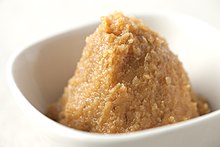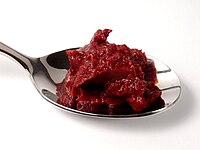List of food pastes
Appearance


This is a list of notable food pastes. A food paste is a semi-liquid colloidal suspension, emulsion, or aggregation used in food preparation or eaten directly as a spread.[1] Pastes are often spicy or aromatic, prepared well in advance of actual usage, and are often made into a preserve for future use. Common pastes are curry pastes, fish pastes, some fruit preserves, legume pastes and nut pastes. Purées, however, are food pastes made from already cooked ingredients, as in the case of cauliflower purée, or raw, as in the case of apple purée.
Food pastes
[edit]Fish and seafood
[edit]

- Fish paste – prepared from fish parts through fermentation[2]
-
- Muria – concentrated garum (fermented fish sauce) evaporated down to a thick paste with salt crystals was called muria;[3] it would have been rich in protein, amino acids, minerals and B vitamins.[4]
- Jakoten – Fried surimi
- Ngapi – Seafood paste used in Burmese cuisine
- Pissalat – French condiment made from anchovies
- Prahok – Cambodian salted and fermented fish paste
- Shrimp paste – made from fermented ground shrimp, either from fresh shrimp or dried ones, with the addition of salt. Prepared shrimp paste often has oil, sugar, garlic, chili, and other spices added.
- Surimi – refers to a paste made from fish or other meat and also refers to a number of Asian foods that use surimi as their primary ingredients
Fruit and vegetable
[edit]
- Baba ghanoush – an eggplant (aubergine) based paste
- Date paste – used as a pastry filling
- Funge de bombo – a manioc paste used in northern Angola, and elsewhere in Africa
- Guava paste
- Hilbet – a paste made in Ethiopia and Eritrea from legumes, mainly lentils or faba beans, with garlic, ginger and spices[5]
- Hummus – made from chickpeas with the addition of tahini, olive oil, lemon juice, salt and garlic[6]
- Moretum
- Pesto
- Quince cheese
- Ssamjang – a Korean sesame- and bean-based paste used as a sauce on meat
- Tapenade – made from olives ground with anchovies or capers, spices and olive oil
- Tomato paste – made from boiling tomatoes until they form a thick paste which is stored for later use in soups, sauces and stews[7]
- Wasabi – Japanese horseradish ground to a fine paste, used in sushi dishes
Grain
[edit]- Farina
- Millet paste – consumed by the Fula people in the Sahel and West Africa,[8] it is a main ingredient in nyiiri, a common Fula dish that is prepared using millet paste and a thick sauce[8]
- Pamonha – a traditional Brazilian paste made from fresh corn and milk
- Polenta
- Mealy pop or bogobe – prepared from ground grain, usually maize or millet, and often fermented before cooking[9]
Instant soup
[edit]
Legume
[edit]
- Black bean paste – type of sweet bean paste
- Cheonggukjang – Korean fermented soybeans
- Doubanjiang – Chinese spicy bean paste
- Doenjang – Korean fermented bean paste
- Fermented bean paste – Fermented foods made from ground soybeans
- Miso – Traditional Japanese seasoning
- Mung bean paste – Species of plant
- Red bean paste – Paste made from adzuki beans
- Sweet bean paste – Bean paste used in Asian cuisines
- Tauco – Indonesian fermented bean paste
- Tương – Condiment made from soybeans
- Yellow soybean paste – Chinese fermented soybean paste
Meat
[edit]
- Chopped liver
- Pâté – finely chopped, finely ground or pureed highly seasoned meat, prepared using beef, pork, liver, or animal organs[10]
- Pheasant paste
- Potted meat food product
Nut and seed
[edit]
- Almond butter – Nut butter made from almonds
- Almond paste – Filling made from almonds and used in pastries
- Cashew butter – Food spread made from baked or roasted cashews
- Lotus seed paste – Chinese dessert ingredient
- Marzipan – made from almonds, with the addition of sugar and sometimes egg whites,[11] it is used as a filling for confections, or hardened to serve as is
- Peanut butter[12]
- Peanut paste – a product of peanuts and is used as an ingredient in sauces, baked goods and breakfast cereals, among others
- Plumpy'nut
- Satsivi – a Georgian specialty made from walnuts, it is used unsweetened as a bread dip, or sweetened as a filling in a baklava-like pastry
- Sunflower butter
- Tahini – made from ground sesame seeds[13]
Spices and herbs
[edit]Herbs
[edit]
Spicy
[edit]
- Biber salçası – Paste made from peppers or tomato and salt, originating in Turkey
- Chili pepper paste – Condiment prepared with chili peppers
- Curry paste – Spicy Asian-influenced dishes
- Ginger garlic masala – Mixture of raw ginger and garlic cloves
- Gochujang – Spicy fermented Korean condiment
- Harissa – North African hot chili pepper paste
- Jeow bong – sweet and savory Lao chili paste
- Phanaeng curry paste – Thick, salty, sweet red Thai curry paste
- Recado rojo – Spice blend
- Sambal – Indonesian spicy relish or sauce
- Ssamjang – Spicy soybean paste used in Korean cuisine
- Yuzukoshō – Japanese fermented citrus and chili paste
Sweet
[edit]- Cookie butter
- Fondant – a basic sugar paste used as an intermediary in the production of candies and icings[14][15]
Yeast extracts
[edit]
Yeast extracts, usually as byproduct from brewing beer,[16] are made into food pastes, usually dark-brown in color.
- AussieMite – Company producing savory food spread
- Cenovis – Swiss brand of spread similar to Marmite
- Guinness Yeast Extract – Irish savoury spread
- Marmite – UK brand of yeast extract spread
- Marmite (New Zealand) – Brand of spread made from yeast in New Zealand
- Oxo – Food ingredient brand
- Promite – Food paste
- Vegemite – Australian brand of spread made from yeast
- Vitam-R – Food product from processed yeast
See also
[edit]- Huff paste
- List of condiments
- List of dips
- List of spreads
- Mortar and pestle – a kitchen device used since ancient times to prepare ingredients or substances by crushing and grinding them into a fine paste or powder
- Wet grinder – a food preparation appliance used especially in Indian cuisine for grinding food grains to produce a paste or batter
References
[edit]- ^ Kipfer, Barbara Ann (2012). The Culinarian: A Kitchen Desk Reference. New York: Wiley. p. 409. ISBN 978-1-118-11061-4.
- ^ Lee, Cherl-Ho; Steinkraus, Keith H. & Reilly, P. J. (1993). Fish Fermentation Technology. New York: United Nations University Press. ISBN 978-89-7053-003-1.
- ^ Saberi, Helen, ed. (2011). "Roman fish sauce. An experiment in archaeology". Cured, Smoked, and Fermented: Proceedings of the Oxford Symposium on Food. Prospect Books, Oxford Symposium, 2011. p. 121. ISBN 9781903018859.
- ^ Curtis, Robert I. (1984) "Salted Fish Products in Ancient Medicine". Journal of the History of Medicine and Allied Sciences, XXXIX, 4:430-445.
- ^ "Spaghetti silsie, or spicy fragrant tomato pasta sauce (Eritrea)". Vegventures. Archived from the original on 14 January 2012.
- ^ Zubaida, Sami (2000). "National, Communal and Global Dimensions in Middle Eastern Food Cultures". In Zubaida, Sami; Tapper, Richard (eds.). A Taste of Thyme: Culinary Cultures of the Middle East. London: I.B. Tauris. p. 35. ISBN 978-1-86064-603-4.
- ^ Kipfer 2012, p. 561
- ^ a b Regis, H.A. (2002). Fulbe Voices: Marriage, Islam, And Medicine In Northern Cameroon. Westview case studies in anthropology. Avalon Publishing. p. pt54. ISBN 978-0-8133-4706-6. Retrieved June 29, 2017.
- ^ Akinrele, I. A. (2006). "Fermentation studies on maize during the preparation of a traditional african starch-cake food". Journal of the Science of Food and Agriculture. 21 (12): 619–625. doi:10.1002/jsfa.2740211205.
- ^ Kipfer 2012, p. 412
- ^ Kipfer 2012, p. 354
- ^ Russell, Percy (1995). The Nutrition and Health Dictionary. New York: Chapman and Hall. p. 327. ISBN 978-0-412-98991-9.
- ^ McGee, Harold (2004). On Food and Cooking: The Science and lore of the Kitchen. New York: Simon and Schuster. p. 514. ISBN 978-0-684-80001-1.
- ^ Kipfer 2012, p. 241
- ^ Jones, David (2011). Candy Making For Dummies. New York: Wiley. pp. 65–68. ISBN 978-1-118-05461-1.
- ^ Sombutyanuchit, P.; Suphantharika, M.; Verduyn, C. (2001). "Preparation of 5′-GMP-rich yeast extracts from spent brewer's yeast". World Journal of Microbiology and Biotechnology. 17 (2): 163–168. doi:10.1023/A:1016686504154. S2CID 82000729.
External links
[edit] Media related to Sugar paste at Wikimedia Commons
Media related to Sugar paste at Wikimedia Commons Media related to Sweet bean paste at Wikimedia Commons
Media related to Sweet bean paste at Wikimedia Commons Media related to Tomato paste at Wikimedia Commons
Media related to Tomato paste at Wikimedia Commons

